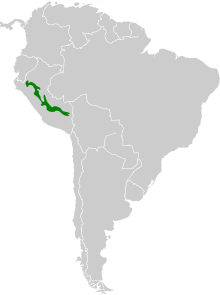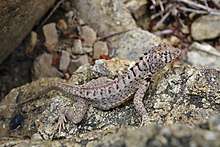Maria Koepcke
Maria Koepcke (15 May 1924 – 24 December 1971) was a German ornithologist known for her work with Neotropical bird species. Koepcke was a well-respected authority in South American ornithology in a time when the field was largely dominated by men and her work is still referenced today. For her efforts, she is commemorated in the scientific names of four Peruvian bird species and, along with her husband, a Peruvian lizard species.
Maria Koepcke | |
|---|---|
| Born | Maria Emilie Anna von Mikulicz-Radecki 15 May 1924 |
| Died | 24 December 1971 (aged 47) |
| Cause of death | Crash of LANSA Flight 508 |
| Nationality | German |
| Alma mater | University of Kiel |
| Spouse(s) | Hans-Wilhelm Koepcke |
| Children | Juliane Diller |
Biography
Maria Emilie Anna von Mikulicz-Radecki was born in Leipzig, Saxony, Germany on 15 May 1924,[1] the daughter of Felix von Mikulicz-Radecki, a university professor of gynaecology, and Käthe Finzenhangen.[2] Her father's family descended from Polish nobility and the Polish surgeon Jan Mikulicz-Radecki was a relative of hers.
As a young woman, Koepcke set out to study animals. It was in 1949 that Koepcke obtained her doctorate in zoology from the University of Kiel. During her time in Kiel, she met her future husband, Hans-Wilhelm Koepcke, also a student of zoology. After receiving their degrees, the two traveled to Peru in order to study birds and other wildlife native to the area and they were married there in 1950.[1] They lived in Miraflores, a suburb of Lima, and managed Casa Humboldt,[3] a visitor's centre, until it closed in 1967. The Koepckes’ only child, a daughter named Juliane Margaret Beate Koepcke, was born in Lima in 1954.[4]
Koepcke died at the age of 47 following the crash of LANSA Flight 508 in the Peruvian jungle.[5] On 24 December 1971, she and Juliane boarded the ill-fated flight to travel to Pucallpa, where Hans-Wilhelm was working at the time, to spend Christmas there with him. The plane crashed due to a lightning strike during a heavy storm. Separated during the crash, it later was determined that Maria had been mortally wounded and died several days afterwards from her injuries. Her daughter, Juliane, wound up being the only survivor of the crash, having fallen from 10,000 feet, still strapped into her seat that, apparently, cushioned her landing. Although injured, without food, and failing to find her mother, the teenager then hiked for eleven days through the rain-forest until she found help.[4]
At the time of her death, Koepcke was a department head for a natural history museum affiliated with the National University of San Marcos in Lima and a member of the German Ornithologists' Society.[1]
After Koepcke's death, Hans-Wilhelm and Juliane both left Peru for Germany, Juliane in 1972, and Hans-Wilhelm in 1974. Hans-Wilhelm lived in Hamburg, teaching zoology at the University of Hamburg until his death in 2000. Like her parents, Juliane studied zoology at the University of Kiel. She became a mammalogist, specializing in the study of bats.[4]
Eponyms
- Koepcke's screech owl, Megascops koepckeae
- Koepcke's hermit, Phaethornis koepckeae
- Koepke's hairy-nosed bat, Mimon koepckeae[6]
- Selva cacique, Cacicus koepckeae
- Sira curassow, Pauxi koepckeae[7]
- Frost's iguana, Microlophus koepckeorum[8] (genitive plural, named in honor of both Maria and her husband Hans-Wilhelm)
 Koepke's Hermit Hummingbird
Koepke's Hermit Hummingbird Range of Koepke's Hermit hummingbird
Range of Koepke's Hermit hummingbird Range of the Selva Cacique Cacicus koepckeae
Range of the Selva Cacique Cacicus koepckeae_(14594631177).jpg) 1838 illustration of the Sira curassow
1838 illustration of the Sira curassow Frost's Iguana: named after Maria Koepcke and her husband
Frost's Iguana: named after Maria Koepcke and her husband
References
- Rea, Amadeo M. & Kostritsky, B. León (1973). "Obituary: Maria Emilie Anna von Mikulicz-Radecki Koepcke" (PDF). Auk. 90 (3): 735–736. doi:10.2307/4084200.
- Niethammer, G. (1974). "Maria Koepcke geb. Mikulicz-Radecki". Journal of Ornithology (in German). 115: 91–92. doi:10.1007/BF01647319.
- Vuilleumier, François (1995). "Five Great Neotropical Ornithologists: An Appreciation of Eugene Eisenmann, Maria Koepcke, Claës Olrog, Rodulfo Philippi, and Helmut Sick" (PDF). Ornitología Neotropical. 6 (2): 97–111.
- Williams, Sally (22 March 2012). "Sole survivor: the woman who fell to earth". The Daily Telegraph.
- "Juliane Koepcke: How I survived a plane crash". BBC News. 24 March 2012. Retrieved 24 March 2012.
- Beolens, Bo. (2009). The eponym dictionary of mammals. Watkins, Michael, 1940-, Grayson, Michael. Baltimore: Johns Hopkins University Press. p. 227. ISBN 978-0-8018-9533-3. OCLC 593239356.
- Corvacho, Melvin Gastañaga; MacLeod, Ross; Brooks, Daniel M.; Hennessey, Bennett (2011). "Distinctive morphology, ecology, and first vocal descriptions of Sira Curassow (Pauxi [Unicornis] koepckeae): evidence for species rank" (PDF). Ornitologia Neotropical. 22: 267–279.
- Beolens, Bo; Watkins, Michael; Grayson, Michael (2011). The Eponym Dictionary of Reptiles. Baltimore: Johns Hopkins University Press. xiii + 296 pp. ISBN 978-1-4214-0135-5. ("Koepcke", p. 144).